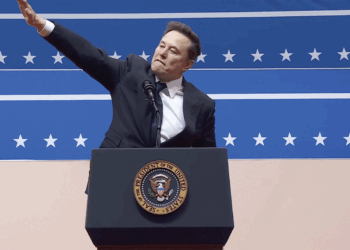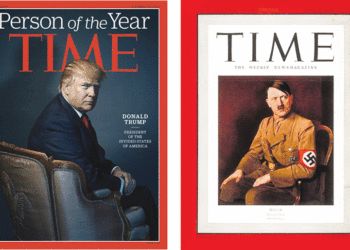One sensational news story displaces another in the unending press cycle. For example, there was the brawl and shootout by outlaw bikers in Waco, Texas, on Sunday, which left nine dead, 18 hospitalized with injuries, and more than 170 arrested.
In the aftermath of the bloodshed in Waco, another shooting spree in Garland, Texas, on May 3, recedes in the popular memory. That incident occurred at an exhibit of caricatures of the Prophet Muhammad, which was organized by an outfit called the American Freedom Defense Initiative (AFDI), headed by Pamela Geller (5-8-15 AJW).
Two men from Phoenix, Ariz., wearing body armor and carrying assault rifles, arrived outside of the cartoon contest. They apparently were set to commit carnage in the cause of avenging perceived insults to the Islamic prophet; but a traffic officer working after hours as a security guard for the event shot and killed the two men.
The attack recalled the January attack by Islamist extremists on the Paris offices of Charlie Hebdo, where 11 magazine staffers and others were murdered; that was followed by another jihadist attack on the Hyper Cacher kosher supermarket, where four people were shot to death.
Regarding the attack in Garland, near Dallas, there is no justification for responding to the exercise of free speech with violence. The “Draw the Prophet” cartoon contest clearly was conceived as a provocation directed at Muslims; however, the First Amendment does not provide any protection from being offended. Americans can take offense at another person’s form of expression, but they cannot demand that others curtail their right to express themselves, even if the speech is seen as blasphemous or otherwise objectionable.
That said, Geller is a noted anti-Muslim bigot who happens to be Jewish. The Southern Poverty Law Center lists Geller in its “Extremist Files” section: “relentlessly shrill and coarse in her broad-brush denunciations of Islam…”
Lior Zaltzman, writing recently in the Forward, acknowledged that Geller had the right to organize the cartoon contest, but argued that no one should pretend it was “a celebration of free speech, in the vein of Charlie Hebdo. It’s not a celebration of free speech. It’s not even a celebration of cartooning.
“In fact, it looks more like a celebration of hate speech, à la Iran International Holocaust Cartoon Contest. Because the Prophet Muhammad is, to Muslims, as sensitive a subject as the Holocaust is to us Jews.”
On another point, ISIS (also known as the Islamic State and ISIL) claimed credit for the attack in Garland, Texas. Elton Simpson, one of the men involved in the Texas attack, was on the radar of law enforcement, and reportedly tweeted prior to the attack: “May Allah accept us as mujahideen.” The Twitter message added that Simpson and his partner had pledged loyalty to ISIS leader Abu Bakr al Baghdadi.
And there is a local angle to the use of social media to recruit for violent jihad.
Both local and national press outlets have reported that Islamist extremists were using Twitter and other social media to encourage attacks on the “Draw the Prophet” cartoon contest.
The New York Times last week reported that a “well-known promoter of the Islamic State who engaged with Mr. Simpson was a jihadist known on Twitter as Mujahid Miski, believed to be Mohamed Abdullahi Hassan, a Somali-American from Minnesota. Though Mr. Hassan lives in Somalia, he has emerged as an influential recruiter for the group.”
Hassan, who attended Roosevelt High School in south Minneapolis, tweeted, in late April: “The brothers from the Charlie Hebdo attack did their part. It’s time for brothers in the #US to do their part.” Simpson retweeted “his call to violence,” according to a source cited by the Times.
It has been reported that “Miski” has used around 30 different Twitter accounts; and many supporters have retweeted his messages.
Beyond the deplorable antics of Pamela Geller and her ilk, there is the problem of young disaffected Muslims traveling to foreign wars in the Middle East, either to get themselves killed or to kill others. Last month, six young Somali-Americans from Minneapolis were arrested and charged in an alleged plot to join ISIS. This follows on an earlier wave of local Somali youths who traveled to their ancestral homeland to fight with the Shabab terrorist group.
In the most recent prosecution, some members of the Somali community have charged that the use of an FBI informant has tainted the case against the six men from Minnesota. U.S. Attorney Andrew Luger has denied that the young men were entrapped. “We don’t set people up,” Luger told a crowd of skeptical Somalis at a community meeting earlier this month in south Minneapolis.
However, the FBI has a history of walking up to the edge of entrapment, and perhaps crossing the line, in “terrorism” sting operations. I have written about the FBI’s pattern of finding wannabe Islamist extremists and providing these knuckleheads with fake bombs and missiles, and setting them on the path of violent jihad.
The “Newburgh 4,” for example, a group of mentally deficient ex-cons, were caught as they were about to bomb synagogues in the New York City area. There were no actual bombs.
I wrote about this case in a 2009 editorial titled “Manufacturing Crimes,” which won the Simon Rockower Award for excellence in editorial writing. An FBI informant played a key role in furthering the alleged acts of terrorism by the Newburgh 4, and the editorial questioned whether the FBI entrapped the defendants.
The Newburgh 4 were eventually convicted; there is a very high bar in our legal system to make a successful entrapment defense.
And, in the case of the local Somali-Americans charged with felonies for allegedly planning to join ISIS, I’m not arguing that they were entrapped. But given the history of the FBI’s use of informants in counter-terrorism cases, the local Somali community, and all of us, should be skeptical.
— Mordecai Specktor / editor@ajwnews.com
(American Jewish World, 5.22.15)


















